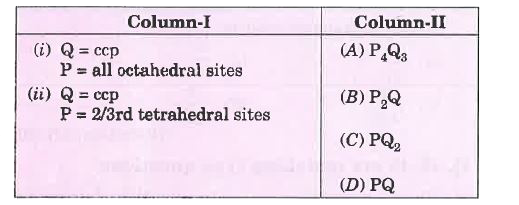Match the oxide of manganese (column I) with its nature (column II)

A
(i)-(A), (ii)- (C)
B
(i) -( C), (ii)-(B)
C
(i)-(A), (ii)-(B)
D
(i) - ( B), (ii)-( C)
Video Solution
Text Solution
The correct Answer is:A
|
Answer
Step by step video, text & image solution for Match the oxide of manganese (column I) with its nature (column II) by Chemistry experts to help you in doubts & scoring excellent marks in Class 12 exams.
Updated on:21/07/2023Topper's Solved these Questions
- D AND F-BLOCK ELEMENTSBook:MODERN PUBLICATIONChapter:D AND F-BLOCK ELEMENTSExercise:REVISION EXERCISES (PASSAGE BASED QUESTION)
Explore 10 Videos
- D AND F-BLOCK ELEMENTSBook:MODERN PUBLICATIONChapter:D AND F-BLOCK ELEMENTSExercise:REVISION EXERCISES (ASSERTION REASON QUESTION)
Explore 10 Videos
- D AND F-BLOCK ELEMENTSBook:MODERN PUBLICATIONChapter:D AND F-BLOCK ELEMENTSExercise:REVISION EXERCISES (OBJECTIVE QUESTION (MULTIPLE CHOICE QUESTION))
Explore 21 Videos
- CHEMISTRY IN EVERYDAY LIFE Book:MODERN PUBLICATIONChapter:CHEMISTRY IN EVERYDAY LIFE Exercise:UNIT PRACTICE TEST
Explore 13 Videos
- ELECTROCHEMISTRY Book:MODERN PUBLICATIONChapter:ELECTROCHEMISTRY Exercise:UNIT PRACTICE TEST
Explore 20 Videos
Similar Questions
Knowledge Check
Match the process (column I) with its name (column II)
 A(i)-(C), (ii)-(B), (iii)-(A)B(i)-(B), (ii)-(C), (iii)-(A)C(i)-(C), (ii)-(A), (iii)-(B)D(i)-(B), (ii)-(A), (iii)-(C)
A(i)-(C), (ii)-(B), (iii)-(A)B(i)-(B), (ii)-(C), (iii)-(A)C(i)-(C), (ii)-(A), (iii)-(B)D(i)-(B), (ii)-(A), (iii)-(C)Match the polymer (column I) with its type (column II)
 A(i)−(D),(ii)−(A),(iii)−(B)B(i)−(A),(ii)−(D),(iii)−(C)C(i)−(D),(ii)−(B),(iii)−(A)D(i)−(D),(ii)−(A),(iii)−(C)
A(i)−(D),(ii)−(A),(iii)−(B)B(i)−(A),(ii)−(D),(iii)−(C)C(i)−(D),(ii)−(B),(iii)−(A)D(i)−(D),(ii)−(A),(iii)−(C)Match the polymer (column I) with its important use (column II)
 A(i)−(C),(ii)−(D),(iii)−(B)B(i)−(C),(ii)−(B),(iii)−(D)C(i)−(B),(ii)−(C),(iii)−(D)D(i)−(C),(ii)−(A),(iii)−(D)
A(i)−(C),(ii)−(D),(iii)−(B)B(i)−(C),(ii)−(B),(iii)−(D)C(i)−(B),(ii)−(C),(iii)−(D)D(i)−(C),(ii)−(A),(iii)−(D)
Match the type of colloid (column I) with its property (column II)

View SolutionMatch the polymer (column I) with its monomer/monomers (column II)

View SolutionMatch the arrangment of P and Q (column I) with its formula (column II)

View SolutionMatch the alloy of copper (column I) with its composition (column II)

View SolutionMatch the polymer (column I) with its structural formula (column II)


View Solution



